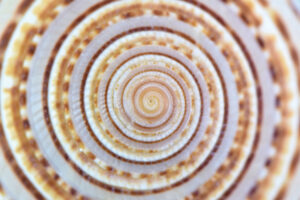The Solace of Numbers
May 20, 2024
Above: Director Lisa Penfold sitting among the activity of the Math Center.
PRIOR TO 2002, ANGIE GARDINER, FORMER DIRECTOR OF UNDERGRADUATE SERVICES IN THE DEPARTMENT OF MATHEMATICS, WAS WORKING WITH HER MATH TUTORS OUT OF TWO OLD WWII BARRACKS SITUATED BETWEEN THE COWLES AND WIDTSOE BUILDINGS ON PRESIDENTS CIRCLE.
Today, things are exponentially better, and not just because of the expanded space, with its beautifully rendered sandstone exterior accented with concrete and glass and illuminated naturally through skylights, rising into an elevated garden patio above. The $1.8 million T. Benny Rushing Mathematics Student Center, where the Math Center is housed, currently speaks to the collaborative, integrated space—both physical and mental—that offers what Gardiner calls a “continual review of mathematics” targeting University of Utah undergraduates enrolled in math classes.
That continuing review is robust as well—on-demand for students who at times just drop in with a quick query or for others who actually use the space as a study hall, raising different-colored felt flags (depending on what area of math they need help with) at their work stations when they need one-on-one attention.
Some of the tutors are graduate students, required, as part of their teaching requirement to work a minimum of one hour per week. There is also a tutor cohort which is more of a fixture, logging many weekly hours. All of these skilled mentors are always at-the-ready, willing and fluidly collaborative with their colleagues who may be more conversant with concepts than they are—whether it's quadratic equations, calculus, or trigonometry. There’s even a dedicated private space for Foundations of Analysis work where students are mentored through “proofs,” a deductive argument for a mathematical statement, showing that the stated assumptions logically guarantee the conclusion.
Discussion is a premium, says Lisa Penfold who took over the direction of the Center in 2018. "If a student discusses the problem with a tutor within 24 hours of a lecture,” she says, “understanding and retention increases” markedly. For the tutors, the benefits are mutual as they benefit in their preparation for the Graduate Record Exam, required for graduate school, by working as a tutor in the Math Center.

Veteran tutor Stella Brower, working with a student.
While designed first to be pragmatic (students need to pass math classes for their generals, but also for their STEM-related majors) the Center inspires students to move beyond the Steps (1,2,3…) to solving an assigned problem to really understand what the meaning is of what they’re looking at. It’s this undergirding mission that has made the Math Center at the U the powerhouse that it is. Tutors, who are skilled at deciphering the students' level of understanding, respond to students in real time.
Helping students to pass their math classes and to better understand math meanings can sometimes be complicated by the all too familiar “math anxiety.” Refrains like "I'll never be able to do math" or "math doesn't even walk in our family" are all too common for some who arrive at the U. The Math Center, with its welcoming atmosphere, private group meeting rooms, computer lab and a break room/kitchen has become a sanctuary for students struggling with the complexities of numbers, equations, and formulas. (It would seem the only thing they might be missing is a climbing wall.)
"Our objective is to make sure students feel welcome here and get the help they need," Penfold states. "We know there's a lot of baggage with mathematics."
Addressing that baggage is one of the Center's core missions. Through extraordinary patience and individualized teaching approaches, tutors work tirelessly to dismantle math anxiety. "We start by acknowledging it's valid," says tutor Caleb Albers, a PhD candidate in applied mathematics. "Then we can begin chipping away at those negative associations.”
“I find that helping students get more of a conceptual understanding … helps a lot,” says Stella Brower, a veteran tutor pursuing a master's in statistics. “I have experience tutoring many different types of learners. There are those that thrive working alongside you as you go through a problem, some that want a tutor to check their work, and then there are those that need a bit of guidance or a refresher on a concept.”
Albers echoes this approach. “The most important thing is to help them ‘learn how to learn’ math for themselves, instead of just showing them how to do one problem.”
The tutoring strategies are as diverse as the students themselves, and “meeting the student where they are,” is the standard operating procedure of the tutoring team. The objective of every interaction is to bring a deep commitment to unlocking each student's individual potential. Penfold encourages a culture of tutors commingling across disciplines, asking each other for support on esoteric concepts. Students from calculus and introductory courses are seen clustering together, facilitating an enervating—even fun— cross-pollination of ideas.
"You'll see six to eight students sitting together,” she says, “some in calculus helping those in an entry-level course.”
The pandemic accelerated the Math Center’s evolution, prompting an online tutoring option that continues facilitating virtual support Monday through Saturday. As the U continues to grow its enrollment, Penfold insists on preserving the Center's uniquely personalized, student-centric approach. Penfold is often stepping onto the floor herself when every seat is taken and helping a student even as they are currently almost doubling the size of the tutoring area and creating satellite centers like the one that recently opened in the Sutton Building to accommodate the number of students using the center.
“If a tutor has a question or encounters something shaky, they’ll ask another tutor. We have grad students, as well as undergrads— everyone talking about mathematics and working together.” Asked what she wants students to know about her facility, she immediately responds that she hopes they find out about the Center and that they then use it as frequently as needed.
It’s a tribute to the hard work and dedication of the Math Center team from the early days in old barracks to today’s open and accommodating facility with both online and in-person options, “This is probably the most difficult challenge faced as a tutor," says Brower. "The ability to change up your teaching methods on the fly is very important when helping a student that just isn’t quite getting it.”
The Math Center helps make that happen every day.
by David Pace
This is the feature story of the latest edition of Aftermath, magazine for the Department of Mathematics.




